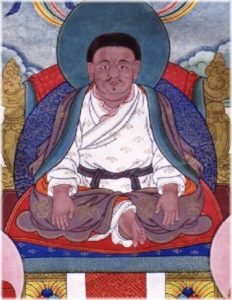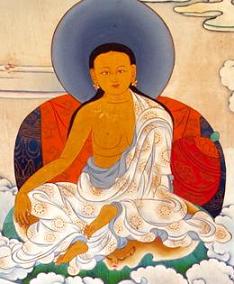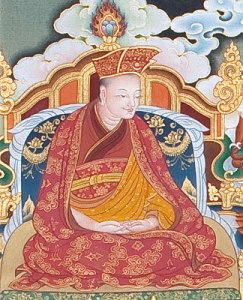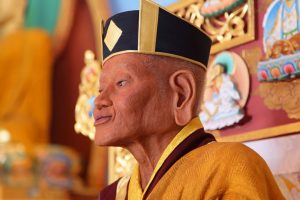Tibetan Masters
Marpa
 Marpa Chökyi Lodrö (Tib. མར་པ་ཆོས་ཀྱི་བློ་གྲོས་, Wyl. mar pa chos kyi blo gros) or Marpa Lotsawa (1012-1097) was a great Tibetan master and translator, and a disciple of Naropa and other great siddhas. He brought many tantras from India to Tibet and translated them. These teachings were passed down through Milarepa and his other disciples, and are the basis of the teachings of the Kagyü lineage.
Marpa Chökyi Lodrö (Tib. མར་པ་ཆོས་ཀྱི་བློ་གྲོས་, Wyl. mar pa chos kyi blo gros) or Marpa Lotsawa (1012-1097) was a great Tibetan master and translator, and a disciple of Naropa and other great siddhas. He brought many tantras from India to Tibet and translated them. These teachings were passed down through Milarepa and his other disciples, and are the basis of the teachings of the Kagyü lineage.
Students:
The four great pillars (Tib. ཀ་བ་ཆེན་པོ་བཞི་, Wyl. ka ba chen po bzhi) or four great students of Marpa Lotsawa are:
- Milarepa (1040-1123), the holder of Marpa’s meditation or practice lineage.
- Ngok Chöku Dorje (1036-1102), the principal recipient of Marpa’s lineages of explanation, and particularly important in Marpa’s transmission lineage of the Hevajra Tantra.
- Tsurtön Wangi Dorje, the principal recipient of Marpa’s transmission of the teachings of the Guhyasamaja Tantra. Tsurton’s lineage eventually merged with the Zhalu tradition and subsequently passed down to Tsongkhapa who wrote extensive commentaries on Guhyasamaja.
- Metön Tsönpo
(www.rigpawiki.org)
Milarepa
 Milarepa (Tib. མི་ལ་རས་པ་, Wyl. mi la ras pa) (1040-1123) is considered to be the founder of the Kagyü school of Tibetan Buddhism. His life story is one of the most popular and enduring narratives in Tibetan culture.
Milarepa (Tib. མི་ལ་རས་པ་, Wyl. mi la ras pa) (1040-1123) is considered to be the founder of the Kagyü school of Tibetan Buddhism. His life story is one of the most popular and enduring narratives in Tibetan culture.
Milarepa was born in the Iron Dragon year of the first sexagenary cycle in a place called Kya Ngatsa in Gungtang in Upper Tibet. He first learned black magic and killed many enemies. Later, feeling remorse for his negative actions, he went to Lhodrak to meet the great Marpa Rinpoche. For about six years and eight months, Marpa made him undergo great hardship for the sake of the Dharma, such as building a nine storey tower, before he finally granted him all the empowerments and instructions. At the age of forty-five, in the Wood Mouse year (1084), Milarepa went to Upper Tibet, and for nine years, moved through Kyirong and Nyal. There he endured hardships, such as wearing only a simple cotton cloth and sustaining himself on nettles, and meditated with such fierce determination that he gained the supreme accomplishment within that very lifetime. Then he went to other places, coming and going, giving instructions of the secret mantra to those who were worthy disciples, and composing many songs of realization. Finally, in the Water Hare year of the second sexagenary cycle, he departed.
Students:
His many disciples, and disciples’ disciples founded all of the Kagyü sub-schools. In addition to his closest two heart-sons who are compared to the sun and the moon (respectively Gampopa and Rechungpa), six were likened to the stars and planets. Altogether they are counted as his eight great heart-sons:
- Ngendzong Repa Changchub Gyalpo,
- Repa Shiwa Ö,
- Sevan Repa,
- Kyira Repa,
- Drigom Repa and
- Repa Sangye Khyab.
Writings:
Milarepa’s collected songs and other works have been published by modern publishers.
(www.rigpawiki.org)
Gampopa Sönam Rinchen
 Gampopa Sönam Rinchen (Tib. སྒམ་པོ་པ་བསོད་ནམས་རིན་ཆེན་, Wyl. sgam po pa bsod nams rin chen) (1079-1153/9) was born in Nyal, Eastern Tibet, he first trained as a physician, hence his name Dakpo Lharje (Tib. དྭགས་པོ་ལྷ་རྗེ་, Wyl. dwags po lha rje), the Physician of Dakpo (the name of the province in which he was to spend many years), became ordained at the age of 26 after his two children and wife died in an epidemic. After studying and practising the Kadampa teachings, at the age of 32 he met Jetsün Milarepa, of whom he was to become the foremost disciple. His own disciples included the first Karmapa Dusum Khyenpa (1110-1193) and Phagmodrupa Dorje Gyalpo (1110-1170).
Gampopa Sönam Rinchen (Tib. སྒམ་པོ་པ་བསོད་ནམས་རིན་ཆེན་, Wyl. sgam po pa bsod nams rin chen) (1079-1153/9) was born in Nyal, Eastern Tibet, he first trained as a physician, hence his name Dakpo Lharje (Tib. དྭགས་པོ་ལྷ་རྗེ་, Wyl. dwags po lha rje), the Physician of Dakpo (the name of the province in which he was to spend many years), became ordained at the age of 26 after his two children and wife died in an epidemic. After studying and practising the Kadampa teachings, at the age of 32 he met Jetsün Milarepa, of whom he was to become the foremost disciple. His own disciples included the first Karmapa Dusum Khyenpa (1110-1193) and Phagmodrupa Dorje Gyalpo (1110-1170).
(www.rigpawiki.org)
The First Karmapa, Dusum Khyenpa
 The birth of the 1st Karmapa, Dusum Khyenpa:
The birth of the 1st Karmapa, Dusum Khyenpa:
Born to a family of devoted Buddhist practitioners in Teshö in eastern Tibet, the boy who was to become known as the first Karmapa was called Gephel as a child. He first studied with his father, and became a knowledgeable and seasoned practitioner, even as a young child. He continued his education with other Buddhist teachers of the region.
(First Karmapa Dusum Khyenpa Statue by 17th Karmapa Statue of the First Karmapa, Dusum Khyenpa, designed by the 17th Karmapa.)
First Teachers:
Already quite learned by the age of nineteen, he moved to Central Tibet, became a monk and spent the next twelve years or so engaging in study and meditation practices. He studied with very well known masters of the time, such as Chapa Chokyi Senge (1109-1169), a great logician and the founder of the debate system in Tibet, and Patsab Lotsawa Nyima Drakpa (1055-?), who translated many madhyamaka texts (one of the highest schools of Buddhist philosophy) into Tibetan and was a great master of the Prasangika Madhyamaka tradition.
Training under Gampopa:
At the age of thirty, he received teachings from Gampopa, the heart son of the greatest yogi in Tibetan history, Milarepa. Düsum Khyenpa first trained in the foundation practices of the Khadampa tradition and, following that, in the general philosophy of the sutras. This training in the basis of all Buddhist traditions established a pattern for all future Kagyu followers by demonstrating the importance of establishing a correct basis of knowledge. This is true even when engaging in the most powerful of advanced vajrayana practices. Düsum Khyenpa also received and unified the lineage teachings he received from Rechungpa and other students of Milarepa.
The Karmapa’s accomplishment in meditation and the practices transmitted to him by his teachers were greatly enhanced by his own natural compassion. His practice produced rapid results and great accomplishments, or siddhis. Such accomplishment is often perceived by followers as the ability to perform miraculous activity and in fact, the legends of the Karmapas through the ages speak of their ability, through the manifestation of this seemingly miraculous activity, to create a great sense of wonder and faith in their students. All the Karmapas have since been known for their ability to inspire, through their simple presence, this profound sense of wonder and faith in the reality of the accomplishment which is the fruition of the Buddhist path.
Establishing monastic seats:
At the age of 55 (1164), Düsum Khyenpa founded a monastery at Kampo Nénang; and at the age of 60 (1169), he started the Panphuk monastery in Lithang, in East Tibet. Later, at the age of 76 (1185), he established an important seat at Karma Gön, in eastern Tibet (1184). At the age of 80 (1189), he established his main seat at Tsurphu, in the Tolung valley, a river which feeds into the Brahmaputra, in central Tibet.
The first Karmapa, Düsum Khyenpa, made predictions about future Karmapas. In particular, he prophesied detailing his future incarnation.
Düsum Khyenpa passed away at the age of eighty-four. Among his other main disciples were Tak-lungpa, founder of the Ta-lung Kagyu, Tsangpa Gyare, founder of the Drukpa Kagyu, and Lama Khadampa Deshek, founder of the Katok Nyingma lineage.
The principal student who held the lineage of the Golden Rosary from the First Karmapa was Drogon Rechen.
(https://kagyuoffice.org)
Facebook Comments